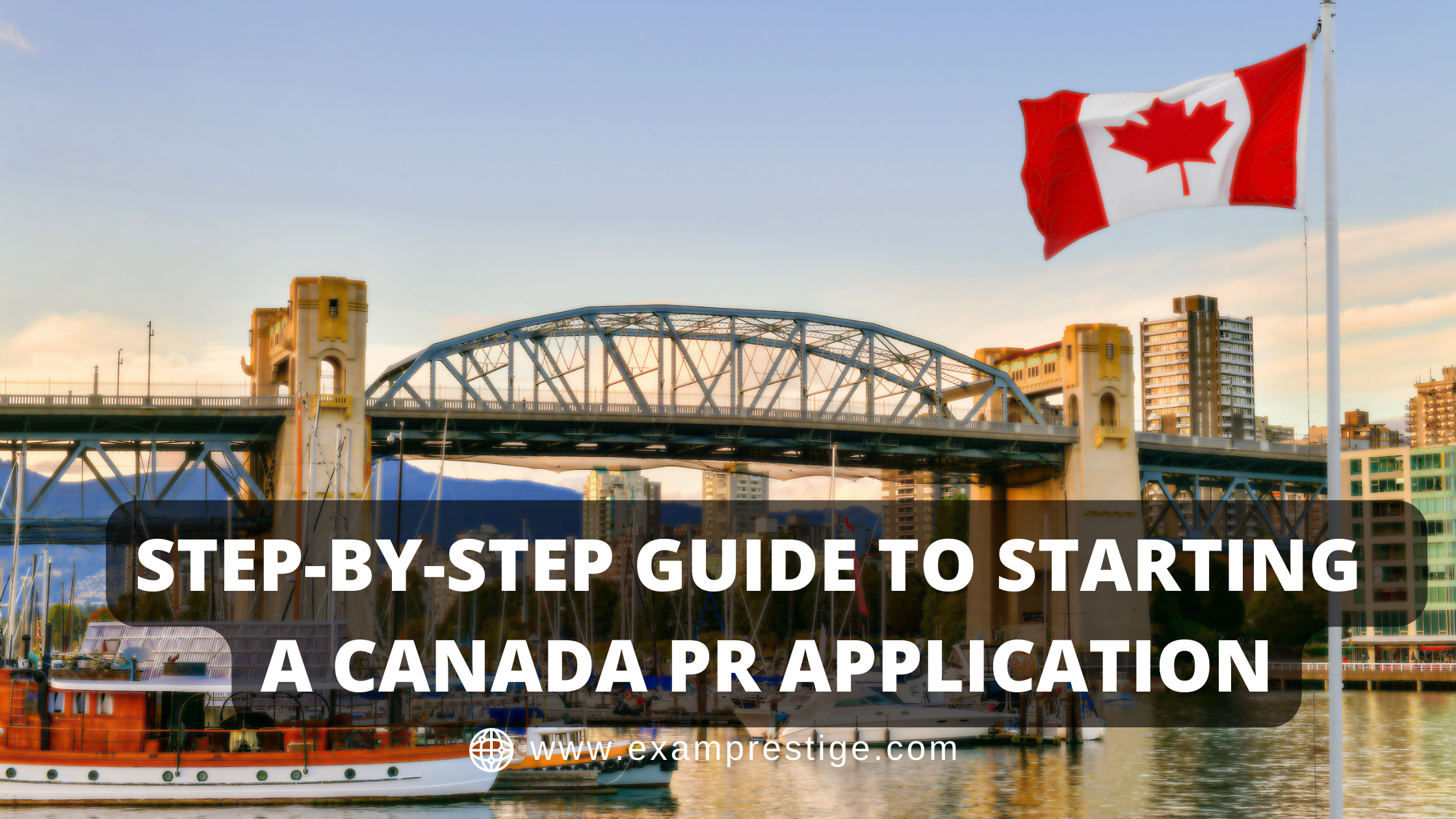If you want to immigrate to Canada, especially without the study route, the Canadian Permanent Residency application is your best bet. Canada welcomed more than 437,000 immigrants in 2022 and plans to increase this number to welcome 465,000 new permanent residents (PRs).

Becoming a Canadian permanent resident is a dream come true for many people. But before then, the Canadian permanent residency application requirements and process can appear complicated, especially for someone who needs a clear roadmap.
Attempting something you’ve not done before without guidance is like a blind man trying to cross the road without help. I don’t think anyone would like to do that, so I’m guessing you’re here to learn how to go about Canada’s permanent residency application. Whether you’re already considering immigrating or just want to learn how to apply for permanent residence in Canada from outside Canada, this blog post is all you need.
Canada is welcoming towards immigrants and attracts them from all over the world. It’s also known for its high standard of living, good healthcare, quality education, and culturally diverse population. Unsurprisingly, the country has one of the most generous immigration systems in the world.
They even have a whole department dedicated to that cause. It is known as the Immigration, Refugees and Citizenship Canada (IRCC)
IRCC – Immigration, Refugees and Citizenship Canada – is the department of the Government of Canada responsible for facilitating the immigration of individuals to Canada, providing refuge to those in need, and delivering programs to assist newcomers in settling in the country. Additionally, they grant citizenship and issue travel documents, like passports, to Canadians.
The Canadian Permanent Residency (PR) program is an initiative of the IRCC to allow individuals to live, work, and study in Canada indefinitely. It is one of the most sought-after immigration programs globally. The application process can take approximately six to eight months to complete. So if you’re considering immigrating to Canada this year, you still have time. You can begin your application right after reading this post.

Steps to Applying for Canadian Permanent Residency from Outside Canada
-
Determine Your Eligibility
In 2015, Canada introduced a system that ranks all Express Entry profiles against one another through the Comprehensive Ranking System (CRS). This system assigns each candidate a CRS score out of 1200 points. Before applying for Canadian permanent residency, you must check your eligibility for any programs and score at least 67 points in the points calculator.
Certain factors like age, education, language proficiency (English and French), work experience, family relationships, and adaptability are considered to get a high score. To be eligible for the program, you must score at least 67 points in the Canada permanent residency points calculator. While there is a minimum score, the express entry process is now very competitive.
-
Choose a Suitable Pathway
There are several pathways to applying to be a Canadian permanent resident. There’s the Federal Skilled Worker Program (FSWP), Canadian Experience Class (CEC), Provincial Nominee Program (PNP), and family sponsorship.

Before applying for permanent residency in Canada from outside of Canada, you should understand the pathways for immigrants. Each has unique eligibility criteria, and you can become a permanent resident through any of them. Some programs are:
Federal Skilled Worker Program (FSWP)
Individuals with skills and professional qualifications seeking permanent residency in Canada may apply for this program. To be considered eligible for this opportunity, you must meet specific requirements, such as language proficiency, work experience, and education.

The Canadian Experience Class (CEC)
This residency category provides permanent status to individuals with skilled work experience in Canada. The CEC program was specifically designed for foreign graduates and temporary foreign workers who have acquired eligible work experience in Canada.
Provincial Nominee Program (PNP)
Canada actively promotes and invites applications for permanent residency from individuals with abilities, education, and work experience that are valuable to the Canadian economy. This pathway is designed for immigrants who want to live and work in a specific province or territory in Canada. There are ten provinces, and three territories in Canada, each with its distinct eligibility criteria and application process.
Provincial and territorial governments select immigrants based on their financial requirements. Each province and territory sets its criteria and procedures for selecting nominees, aiming to nominate individuals who are likely to integrate effectively into the economic and social fabric of the region.
If you choose this pathway, you must apply to the province or territory where you want to live and be nominated. When a province or territory nominates you, you apply to Immigration, Refugees and Citizenship Canada (IRCC) for permanent residence. An IRCC officer will assess your application based on Canadian immigration rules. There are two processes in this pathway. The first is the Express Entry stream, while the second is the Non-Express Entry stream.
Find out more about Express Entry here: Canada Invites 5,500 Express Entry Candidates to Apply for Immigration
The difference between both streams is that the Express-Entry stream is run by the Canadian government, while individual provinces or territories run the Non-Express Entry stream.
Family Sponsorship
This program allows Canadian citizens and permanent residents to sponsor their family members outside Canada to live in Canada. So if you have a family member who’s a permanent resident or citizen of Canada, they can also sponsor you to become a permanent resident.
-
Prepare Your Documents
Once you’ve determined your eligibility, you must prepare all the necessary documents to support your application. These documents include:
- Passport and travel documents
- Language test results
- Educational credentials assessment
- Proof of work experience
- Police certificates
- Medical exam results

Ensure all documents are accurate and up-to-date, as any errors or omissions could delay or even result in the rejection of your application.
-
Create an Express Entry Profile
After choosing the pathway that suits you best, create an express entry profile on the Canada Immigration Express Entry platform. This is a platform used by Canada’s government to manage applications for the FSW, CEC, and PNP programs.
On September 23, 2022, it became mandatory to apply online. However, if you can’t apply online, you can request other formats of the application form.
-
Submit Your Application
Now that you’ve got the required documents and chosen a suitable pathway, submit your application on the IRCC website, including language proficiency test scores, educational qualifications, and work experience documents. Follow all instructions carefully.
-
Wait for a Decision
After submitting your application, you’ll need to wait for a decision from the Canadian government. The decision from IRCC can come in the form of a draw – meaning that The processing time varies depending on the program you’re applying to and other factors such as the volume of applications received. However, the timeline to get a response can be within six to eight months.
During processing, keep your contact information up-to-date and respond promptly if the government requests any additional information or documents.
-
Receive an Invitation to Apply (ITA)
The Canadian government selects the candidates with the highest CRS score (Comprehensive Ranking System) from the Express Entry pool and issues an invitation to apply for permanent residency in Canada. You must submit your complete application, including medical and police clearance certificates, within 60 days of receiving the ITA.
-
Complete your Biometrics
After receiving the ITA, you must provide biometric information such as fingerprints and two digital photographs as part of the application process.

-
Get Your Permanent Residency Visa
Upon approval of your application, you will be granted a permanent residency visa that permits you to reside permanently in Canada. This means you’ll need to send your passport to a Visa Processing Office and send it to be stamped and returned. After this, you can then proceed to Canada.
Remember, completing the landing process within a year of receiving your PR visa and fulfilling the residency obligations to sustain your PR status is mandatory.
-
Prepare for Arrival
If your application is approved, congratulations! You’re now a Canadian permanent resident. Prepare for your journey to Canada and ensure you have all the required documents for entry. Check the travel requirements before heading to the airport.

On arrival in Canada, you must complete the landing process by meeting with an immigration officer to provide your fingerprints and other biometric information.
Also read: Finding the Perfect Fit: A Guide to Choosing a Postgraduate Course to Study in Canada
The Ultimate Guide to Canada Express Entry Eligibility
Applying for Canadian permanent residency can be complex, but it’s worthwhile. By following these steps and seeking professional advice, you can make your dream of living in Canada a reality. After living in Canada for three years as a permanent resident, you may be eligible for Canadian citizenship. This offers access to social benefits.














[…] Source link […]
[…] Learn how to start your Canada Permanent Residency application here. […]
[…] Also read: Step-by-Step Guide to Starting Your Canada Permanent Residency Application […]
[…] also makes applying for Canadian permanent residency easy. In some cases, having a Canadian work permit precedes applying for permanent residency in […]
[…] See also: Step-by-Step Guide to Starting Your Canada Permanent Residency Application […]
[…] that if you intend to apply for permanent residency, a six-month program will not allow you to apply for a work permit. You’re better off […]
[…] Recommended: Step by step guide to starting your Canada permanent residency application […]
[…] funds declared must be available when you apply for Express Entry or are issued a Permanent Resident Visa. You must also be able to prove that you can legally access the money when you arrive in Canada. […]
[…] days, most people can say that they know someone who is either studying, working, residing permanently, or has become a citizen in countries like Australia, Canada, the United States of America, and the […]
[…] world, it’s common for people to know someone who is either studying, working, is a Canadian permanent resident, or has relocated to countries like Australia, the United States of America, or the United Kingdom […]
[…] fill your time, maintain social connections, and stay engaged. Do you want to travel the world, relocate to a new country, or offer humanitarian services? Having a plan informs the kind of decisions you […]